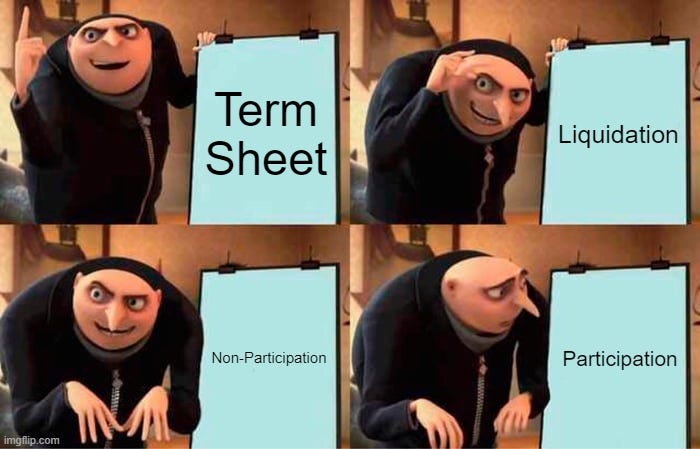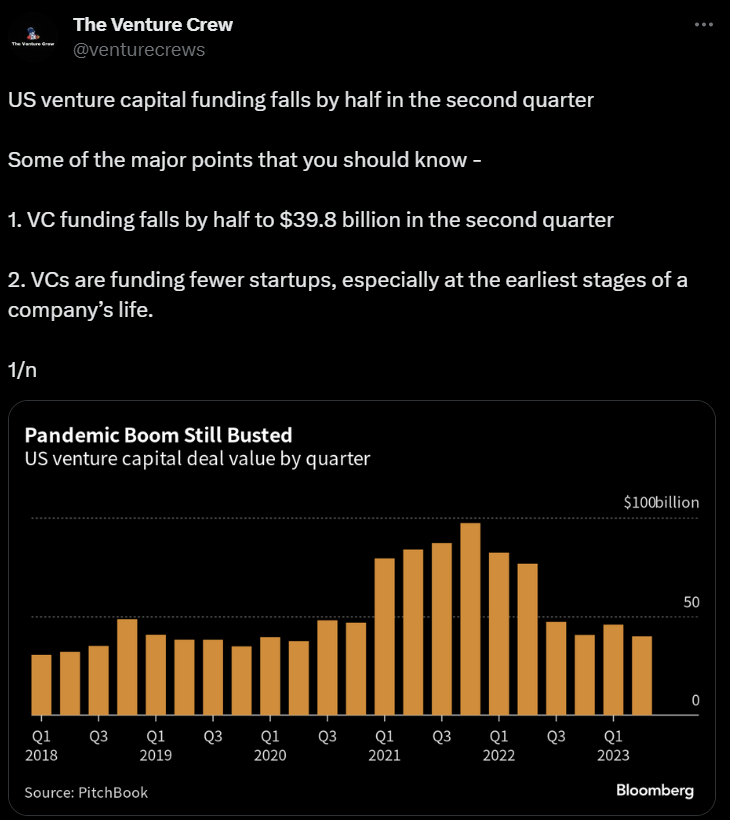Decoding Liquidation Preference, Particiaption & Non-Participation Rights? | YC Startup Index Gives 176% Return | VC Funding Report | Weekend Readings & More
Decoding Term Sheet | YC Startup Index | Weekend Reading Material | VC Remote Jobs
Imagine this scenario: You're buzzing with excitement over your brilliant startup idea, and a venture capitalist shows interest in funding your venture. But hold on a second, there's a crucial hurdle to overcome: term sheets. Suddenly, terms like "1x participation" and "non-participation" start popping up, and you're left scratching your head, wondering, "Do I really need to understand all this legal jargon as a founder?"
Fear not, because I've got your back! Let's demystify these terms together and make sure you're well-equipped to navigate the complex world of startup financing. So grab a cup of coffee, get cosy, and let's get started!
Join 3400+ investors, operators, innovators and students inducing content every week in our VC Newsletter.
Let’s deep dive into it:
I hope you are aware of what is a term sheet. - If not then in the simplest word.
A term sheet is a non-binding legal agreement (non-disclosure and non-sharing) between the founders & investors that shows the investor’s interest in that startup.
Understanding clauses like 1x liquidation participation or non-participation is crucial for both investors and founders in order to protect and maintain the value of their investments during a liquidation event. It is essential for founders to grasp these concepts and make informed decisions about whether a 1X or 2X liquidation preference is the right choice for their circumstances.
Let’s understand this with a simple example:
Consider a startup that got the term sheets from PQR Fund including the investment aspects as follows:
$ Invested: $4M
Pre-Money Valuation: $8M
Post-Money Valuation: $12M
Employee Stock Option Pool: 15%
Liquidation Preference: Let’s take two cases:
Case I: 1X Non- Participating Liquidation
Case II: 1X Participating Liquidation
I hope you are aware of the terms like Pre-money, Post money valuation or option pool. If not then I must say to read our previous writeup on this - Link
If you see the last row, you will find that term called Liquidation Preference. So let’s understand this term first.
Liquidation Preference:
It is the priority that investors have in receiving proceeds (money) from the sale or liquidation of a company. In layman's terms, it means that the investors with a liquidation preference have the first right to get their money back before any proceeds are distributed to other shareholders.
For example,
if an investor has a liquidation preference of 1x, they would get their initial investment back before any proceeds are distributed to other shareholders. If the investor has a liquidation preference of 2x, they would get twice their initial investment before any proceeds are distributed to other shareholders. Here In this term sheet, you can see VC fund PQR have 1X liquidation preference. It means in case of liquidation of the company, funds PQR first received the initial invested amount back before any proceeds are distributed to other shareholders.
There are two other terms also involved in it - participation and non-participation liquidation preference. Let’s understand both the terms, participation, and non-participation liquidation preference.
Non-Participation Liquidation Preference:
Upon liquidation, non-participating investors have the choice of receiving their funds in one of two ways: either based on a 1X preference or according to their stake in the company. Investors typically compare the potential returns from each option and select the one that would provide the most benefit for them.
Ex - Suppose for fund PQR - if in liquidation (sale) of a company valued at $10 M. let’s calculate the return for investors from both ways:
1. 1X liquidation means investors get 1X of the investment amount - so $4M OR
2. Based on the percentage of stake - 33% * $10M (Valuation) - $3.3M.
So after calculation, it’s clear that option 1 - 1X liquidation preference gives more return to the investor hence he will choose the 1X option and get a return of $4M. And the rest amount of $6M ($10M - $4M) will distribute to other shareholders.
Participation Liquidation Preference:
During the liquidation of a company, investors with a participation liquidation preference are entitled to receive their funds through both methods - a 1X preference and a percentage of their stake in the company.
Ex -
Let’s take the same example as above if the fund PQR took the 1X participation liquidation preference then the calculation would be the same - but investors will get a return from both ways so 1X liquidation preference = $4M and Based on percentage stake = $3.3M. So total return for the investor = $4M + $3.3M = $7.3M and the rest amount of $2.7 ($10M - $7M) will be distributed to another stakeholder.
As a founder, if your company is liquidated and there is a participation liquidation preference in place, your returns will be minimal. Therefore, it's advantageous to have a 1X non-participation liquidation preference in the term sheet. Additionally, most venture funds typically use a 1X non-participation liquidation preference as it aligns the interests of investors and other stakeholders in the event of company liquidation.
I hope this write-up will help you to understand these clauses.
If you want to learn more about the term sheet, must recommend reading our previous writeups on the term sheet - here
On The 176% Annual Return of a YC Startup Index
If you had invested in every YC startup at Demo Day since the accelerator’s founding in 2005, you would have made a whopping 176% average annual return net of dilution² (practically speaking this would be impossible, but more on that later).
This is far greater than other asset classes and even top-decile venture capital funds:
Below are overall seed-stage YC startup investment returns broken down by year. Even ‘modest’ years like 2010–2011 produced 70–80% average annual returns, and the stronger years like 2012–2013 saw 300%+ average annual returns………. Read More here
US venture capital funding falls by half in the second quarter
1. VC funding falls by half to $39.8 billion in the second quarter
2. VCs are funding fewer startups, especially at the earliest stages of a company’s life.
3. Investors financed 3011 startup funding deals last quarter about a third fewer than a year ago.
Friday Weekend’s Startups, VC & Tech Reading 📚
Why Training Your Customers is a Genius Go-to-market Strategy? - Read Here
AI and the automation of work - Read Here
Deep learning pioneer Andrew Ng says companies should get ‘data-centric’ to achieve A.I. success - Read Here
Vitalik Buterin on crypto's future, SBF, AI fears, zk-SNARKs and more (Podcast) - Watch Here
VCs reveal how hard it was for their startups to fundraise in H1 2023 - Read Here
Today’s Remote Jobs 👨💼
Dropbox Venture - Corporate Development Ventures Associate - Hybrid - Apply
Flashpoint Venture - Investment Analyst Intern - Hybrid - Apply
Giffins Venture - Fund Administrator - Hybrid - Apply
a16z Venture - Partner Crypto Fund - Hybrid - Apply
📢 Join The Venture Crew Community of 500+ Investors, Founders, Operators & VC Enthusiast!
IMAGINE A PLACE...
where you’re surrounded by investors, founders, operators, vc enthusiasts & high skills professionals who you can grow with and learn from.
📢 Exciting News for Founders, Investors & VC Enthusiasts - Resource Page On Website
What does this resource page contain?
Crews Event Calendar: Find all event info...
Investors Contact Database (Email + LinkedIn Id) - US, India, France, Australia & Africa... will add more soon
VC Career Guide: Find all curated resources by leading vc to learn about venture capital.
Knowledge Hub: Find all curated resources and top industry reports free for vc, founders & vc enthusiasts.
That’s it for today….. Happy weekend!
By - The Venture Crew!








